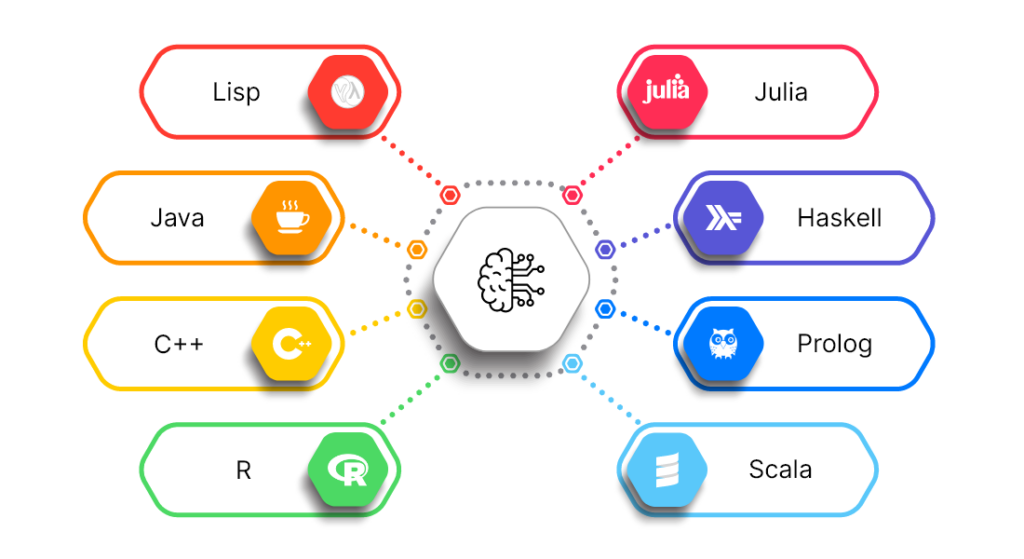Crypto Wallet App Development: Features,...
April 14, 2025

By Dharmesh Patel
June 7, 2024/96,710
 In 2024, organizations are wholeheartedly embracing cutting-edge AI technologies to maximize efficiency and foster innovation. By integrating AI into workflows, they aim to unlock unprecedented productivity and competitive advantage. The landscape of AI development programming languages is set to transform, bringing new capabilities and possibilities.
In 2024, organizations are wholeheartedly embracing cutting-edge AI technologies to maximize efficiency and foster innovation. By integrating AI into workflows, they aim to unlock unprecedented productivity and competitive advantage. The landscape of AI development programming languages is set to transform, bringing new capabilities and possibilities.
Developers have the autonomy to select the best programming language for AI that aligns with their project objectives. This integration signifies a leap toward a future of intelligent automation, optimizing processes, and nurturing revolutionary solutions. With the impending upgrades in AI programming languages, organizations and developers are poised for unprecedented innovation, reshaping the way we work with technology.
From long standing languages with rich ecosystems to arising ones that are picking up speed, we will explore the full spectrum of programming choices accessible to artificial intelligence developers.
There is no definitive answer when it comes to choosing the Best Programming Language for AI because it is heavily dependent on the project’s individual objectives and context.
In any case, a few programming languages have gained fame and respect for their effectiveness in creating AI applications.
Python, with its effortlessness, adaptability, and broad scope of libraries and systems, is generally viewed as one of the top decisions for artificial intelligence improvement. Its intelligibility and convenience make it accessible for beginners, while its robust ecosystem provides powerful tools like TensorFlow, PyTorch, and scikit-learn for implementing machine learning development and deep learning algorithms.
Also, Python’s mixed abilities empower consistent cooperation with different advancements and frameworks.
R is another well-known programming language that focuses on statistical analysis and data visualization, making it ideal for AI researchers and data scientists. Java, known for its scalability and performance, is employed in AI applications that require extensive processing and distributed systems.
Meanwhile, low-level control and efficiency are provided by languages like C++, making them perfect for AI performance-critical workloads. Finally, selecting the best AI programming language necessitates considering factors like the project’s complexity, existing infrastructure, the skill of the development team, and the specific AI approaches being employed.
Read More: AI App Development Framework
Table of Content
Toggle
Lisp is a programming language that was made in the last part of the 1950s and is known for its remarkable syntax and powerful features.
Pros- Compared with more standard languages, Lisp has a smaller community and ecosystem. This implies there might be fewer libraries and devices accessible for specific tasks, and finding support or resources can sometimes be more challenging.
Cons- It is a useful programming language, and that implies it underlines permanent information and capabilities without secondary effects. This worldview works with writing clean, modular, and reusable code, and it is appropriate for assignments including complex information changes and AI algorithms.
Java
Java is a universally useful programming language that is generally utilized in big business applications. It has a rich environment of libraries and systems for simulated AI development, like Deeplearning4j and Weka.
Pros- Java has an enormous and active local area of developers around the world. This implies there are online resources, forums, and communities where designers can look for help, share information, and work together on projects.
Cons- Java applications ordinarily have a more drawn-out startup time compared with languages that gather to native code. This can be a worry for specific kinds of uses, for example, command-line tools or small scripts.
C++ is a general-purpose programming language known for its efficiency, performance, and versatility.
Pros- C++ is often praised for its performance and efficiency. It permits low-level admittance to memory and gives direct command over hardware resources, making it appropriate for applications that request superior execution, for example, AI algorithms that require intensive computations.
Cons- C++ gives developers manual command over the memory of the executives, which can be both a benefit and a test. While it takes into consideration fine-grained control and performance optimization, improper memory handling can prompt bugs, memory leaks, or indistinct ways of behaving.
R is a language explicitly intended for data analysis and statistical computing. It has a huge variety of libraries and packages for machine learning and data visualization, making it well-known among statisticians and data scientists.
Pros- R has great information data visualization libraries, for example, ggplot2, which permit you to make top-notch and adaptable plots and graphs. It makes it simple to investigate and communicate bits of knowledge from your information data.
Cons- While R is incredible for intelligent information data analysis and prototyping, it very well may be slower contrasted with languages like C++ or Java with regard to computationally escalated assignments. Be that as it may, this can be moderated by incorporating R with quicker languages for performance-critical sections of code.
Julia is a somewhat new programming language that is acquiring popularity in the AI community. It is intended for high-performance numerical computing and has underlying help for conveyed figuring and parallelism.
Pros- Julia has great interoperability with other programming languages, like Python, C, and R. It can undoubtedly call capabilities from these languages and coordinate with existing codebases. This adaptability permits developers to use existing libraries and devices from various different ecosystems.
Cons- Compared to more established languages like Python and R, Julia is still moderately new. While it has a developing community and ecosystem, it might not have a similar degree of development, steadiness, and industry support as a few different languages. This can bring about fewer resources and examples accessible for specific explicit use cases.
Haskell is a statically typed functional programming language known for its strong type system, purity, and advanced features.
Pros- Haskell has a strong static type system that helps catch many errors at compile-time, reducing the likelihood of runtime errors. The sort framework additionally upholds progressed highlights like sort inference, allowing the compiler to deduce the types of expressions without explicit type annotations.
Cons- While Haskell offers astounding execution, by and large, streamlining execution can some of the time be more difficult compared with lower-level languages like C or C++. The sluggish assessment model and the need to carefully manage strictness and resource usage might require extra work to accomplish ideal execution.
Prolog is a logic programming language that is based on formal logic and provides a declarative approach to programming.
Pros- Prolog permits programmers to communicate issues and arrangements in a coherent and definitive way. Rather than focusing on the most proficient method to tackle an issue step by step, developers can characterize connections and imperatives and let the Prolog translator find the arrangements in view of logical inference.
Cons- Prolog’s explanatory and rationale-based programming worldview can be trying for programmers who are familiar with a goal or article-situated languages. Understanding and really using Prolog’s example to coordinate legitimate inference, and search mechanisms might require a huge learning effort.
Scala is a general-purpose programming language that blends object-oriented programming (OOP) and functional programming (FP) paradigms. It runs on the Java Virtual Machine (JVM) and provides interoperability with Java code.
Pros- Scala is intended to be completely viable with Java, and that implies Scala code can call Java code and vice versa. This interoperability permits designers to use existing Java libraries and frameworks, making it more straightforward to take on Scala in projects with a current Java codebase.
Cons- Scala code can have longer form times and higher arrangement compared with languages like Java. The type inference process and the complexity of the language can result in slower build times, especially for larger projects.
All in all, 2024 offers a scope of programming languages for AI development. Python stays dominant with its libraries and adaptability. R succeeds in statistical analysis and data visualization. Java is dependable for big business-level applications. Julia and Quick are promising arising choices. The decision relies upon explicit requirements and inclinations. Remain informed, investigate new languages, and embrace consistent figuring out how to stay up with AI advancements in 2024 and beyond.
What is the best programming language for AI?
Python is widely considered one of the best programming languages for AI.
Why is Python considered the best programming language for AI?
Python is a significant code language for AI and ML. It outperforms Java in fame and enjoys many benefits, for example, a great library ecosystem, Good visualization options, A low entry barrier, Community support, Flexibility, Readability, and Platform independence.
Can I use Java or C++ for AI development?
Yes, both Java and C++ can be used for AI development.
Can I use multiple programming languages for AI development?
Yes, you can use multiple programming languages for AI development.
Which language should a beginner choose for AI programming?
Python is a good choice for beginners in AI programming. Its simplicity, readability, and extensive library support make it accessible and beginner-friendly.4

Written by Dharmesh Patel
Meet our cloud tech expert, Dharmesh Patel, Director at Inexture Solutions. With over 10+ years of experience in the cloud technology domain, his expertise lies in AWS EC2, S3, VPC, and CI/CD. His interests include storage virtualization, cloud implementation, and performance monitoring, and he has vast knowledge in these fields. He always stays up to date on the newest cloud computing developments and enjoys experimenting with new technologies to discover the best solutions for our clients.

